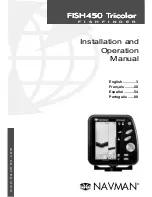
7
FISH450 Tricolor FISHFINDER
Installation and Operation Manual
NAVMAN
Fish detection
The FISH450 Tricolor analyses all received echos
and recognises the characteristic patterns returned
by fish. These echos are displayed on the screen
as a fish symbol. The default setting is for an
associated depth to be shown with fish symbols.
Advanced users sometimes prefer to turn off the
fish symbol feature and interpret the echo patterns
themselves. The following is an example with fish
symbols turned off:
Fish History screen
The
Fish History
screen displays the most recent
signals on the right of the screen, and the oldest
signals on the left. Vertically, this screen always
displays between the surface and the selected depth
range. This screen is often used to find fishing spots.
Selected
range
e.g. 0-30 m
3-2 Fish History and Zoom Screens
Zoom screen
The
Zoom
screen is used to view greater detail in
an area of interest (e.g. fish close to the bottom).
The right portion is the
Full Range Section
and
the left is the
Zoom Section
.
The
Zoom Bar
, located on the very right of the
screen, determines the depth range of the
Zoom
Section
and the amount of magnification:
The
Full Range Section
illustrated is 0 to 30 m and
the
Zoom Bar
is between 14 and 29m. Therefore
the area between 14 and
29m is enlarged in the
Zoom Section
.
To set the depth of the
Zoom Section
, move the
Zoom Bar
up or down by
pressing the
Cursor Up
or
Down
key. To make
the
Zoom Bar
smaller (to
increase magnification),
press the
Cursor Left
key. To make the
Zoom
Bar
bigger (to decrease
magnification), press the
Cursor Right
key.
The
Zoom Bar
can be adjusted in the
Fish History
screen before switching to the
Zoom
screen.
Zoom
Section
Depth of
Bottom
Water Surface
Temperature
Speed
Alarm symbols, see the
Alarms
section 3-1.
Bottom
Fish symbol,
with depth
Object (e.g.
seaweed)
Zoom Bar
Zoom Bar
Full
Range
Section
14
29
Note 1: This screen can be customised. (see
Setup
- Display
section 4-6)
Note 2: The Depth of Bottom can be adjusted for
Keel Offset
. (see
Setup - Depth
section 4-3)
Single fish
Large
school of
fish
Small
school of
fish
Bottom
Strength of returned echos
The three colours indicate differences in the
strength of the returned echo:
blue
is the strongest,
red
is medium strength and
green
is the weakest.
There are several reasons why the strength of the
returned echo varies:
• The size of the fish, school of fish or other
object.
• The depth of the fish or object.
• The location of the fish or object. The area
covered by the ultrasonic beam is
approximately cone-shaped and strongest in
the centre.
• The clarity of water. Particles or air in the
water reduce the strength of the returned
echo.
• The composition or density of the object. Soft
mud produces weaker echos than rock.
Planing hulls at speed produce air bubbles and
turbulent water that bombard the transducer. The
resulting ultrasonic noise may be picked up by the
transducer and obscure the real echos.





















